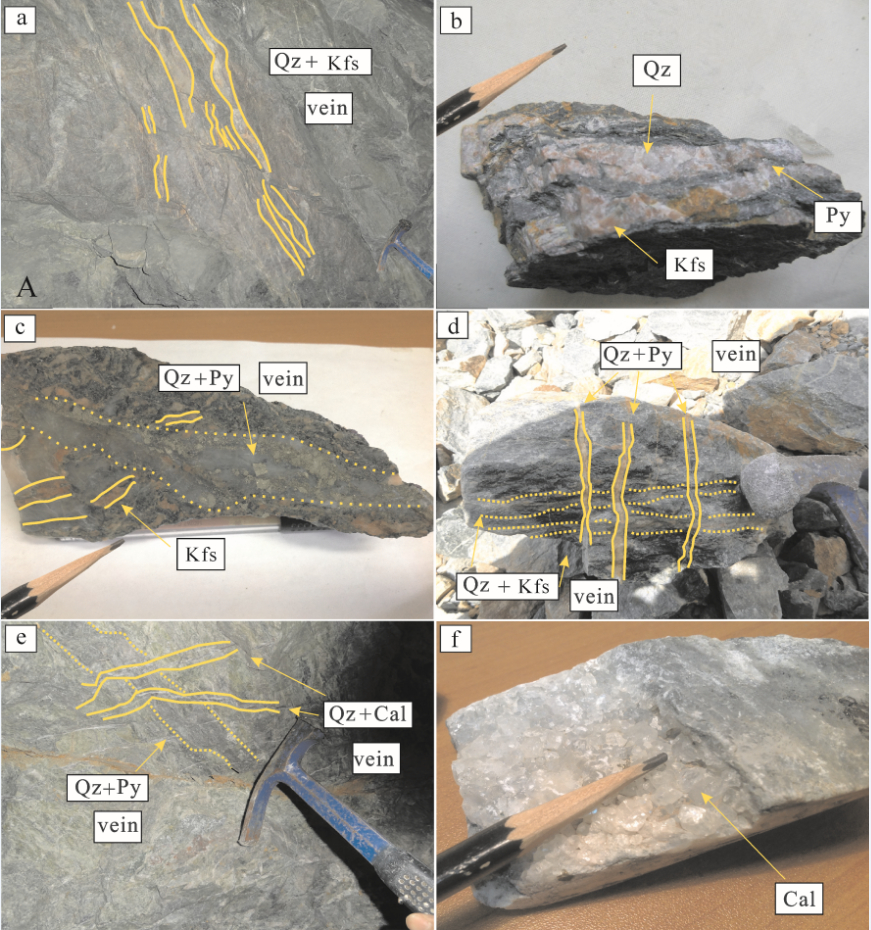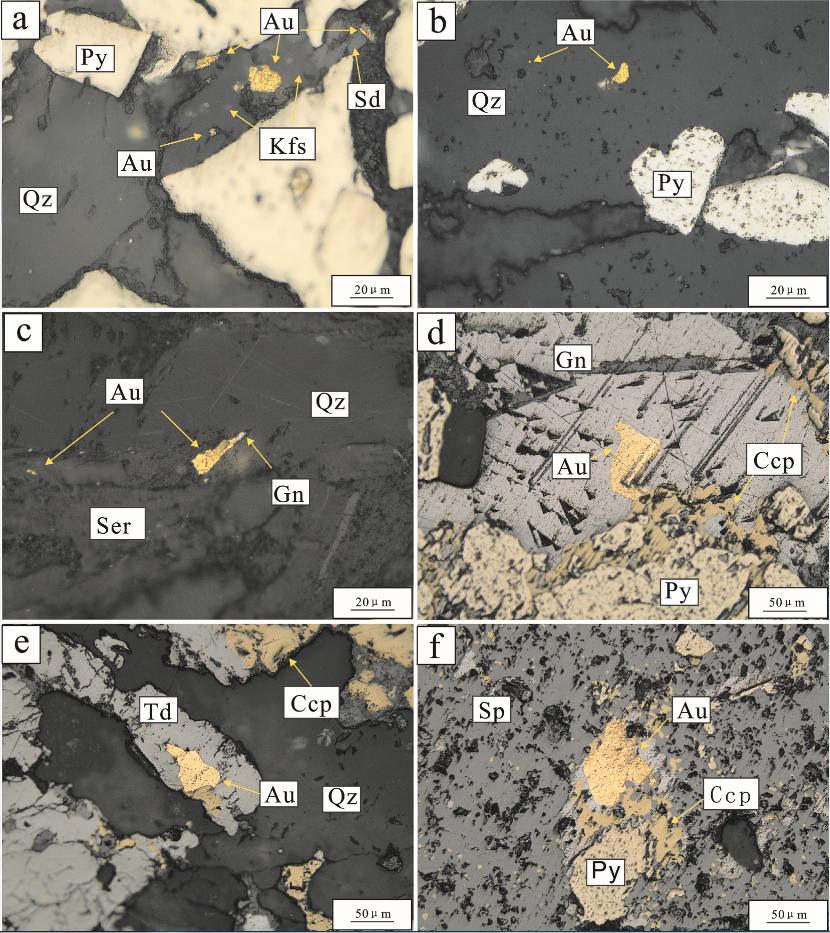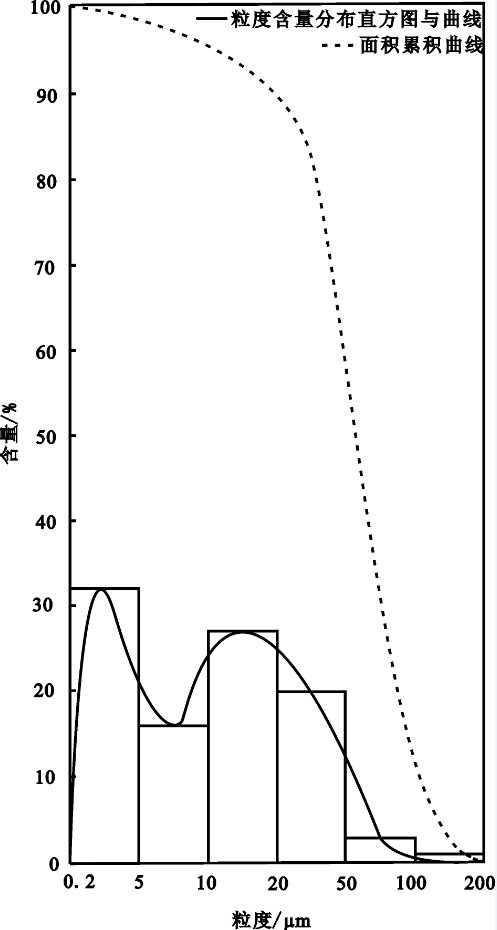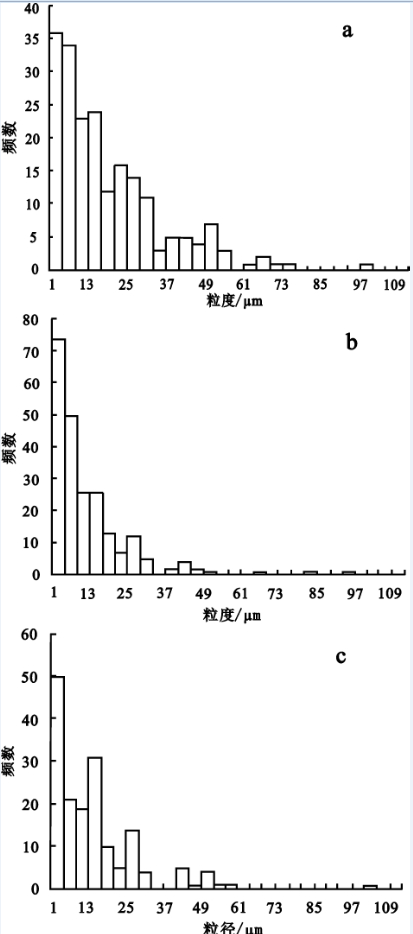Modes of occurrence of gold in the Xindigou gold deposit, Inner Mongolia
-
摘要: 内蒙古新地沟金矿床为一典型绿岩型金矿。利用显微镜、扫描电子显微镜观察到自然金602粒。研究表明,金的赋存形式主要有包体金、裂隙金、粒间金和连生金。载金矿物以黄铁矿、石英为主,所占比例达到95%;其次是钾长石、绢云母、菱铁矿、褐铁矿、黝铜矿、方铅矿、闪锌矿等。自然金的粒度主要以显微极微粒金(0.2~5 μm)、显微细粒金(10~20 μm)、显微中粒金(20~50 μm)、显微微粒金(5~10 μm)为主,分别占32.23%、26.91%、20.6%、16.11%;手标本及显微镜下也能观察到显微粗粒金(50~100 μm)和巨粒金(100~200 μm),虽然其含量仅占4.15%,但其面积可达33.97%,对于矿石品位和储量来说十分重要。电子探针和物相分析显示,矿石中金主要以独立矿物存在,包括大量的自然金和少量的银金矿;通过计算表明金的平均成色为803,金矿物的成色和特征反映金矿形成条件为中温和中等深度。Abstract: The Xindigou gold deposit in Inner Mongolia is a typical greenstone belt gold deposit. Microscope and scanning electron microscope were used to study the modes of occurrence of gold. 602 grains of native gold were recognized, including inclusion, fissure-filling, and intergranular and interlocking gold. The gold-hosting minerals are mainly pyrite and quartz, which account for 95% of the total gold-hosting minerals, and minor K-feldspar, sericite, siderite, limonite, tetrahedrite, sphalerite, galena were also identified. On the basis of statistics, the gold granularity is mainly characterized by micro extra particulate (0.2-5 μm), micro fine particulate (10-20 μm), microscopic medium (20-50 μm), and micro particulate (5-10 μm) grained gold, accounting for 32.23%, 26.91%, 20.6%, and 16.11%, respectively. The micro coarse-gained gold which was observed in the sample and under the microscope is relatively minor but plays an important role in the ore grade and total resource. Electron microprobe analysis and phase analysis show that gold occurs mainly as independent gold minerals. The gold minerals are mainly native gold and secondary electrum (the average fineness is 803), which indicates that gold was formed under the condition of medium temperature and depth.
-
Keywords:
- Xindigou /
- gold ore deposit /
- modes of occurrence /
- fineness /
- Inner Mongolia
-
-
图 1 大青山地区新地沟金矿区域地质简图(据文献[1]修改)
1—古近—新近系、第四系;2—集宁岩群;3—乌拉山群;4—二道凹群;5—查尔泰山群;6—晚古生代—中生代地层;7—太古宙深成侵入体;8—古元古代侵入体;9—晚古生代侵入体;10—中生代侵入体;11—不整合线;12—地质界线;13—推覆构造;14—断层;15—金矿体(点)
Figure 1. Regional geological sketch map of the Xindigou gold deposit in Daqing Mountain (modified after reference [1]).
1-Quaternary, Tertiary;2-Jining Group; 3-Wulashang Group; 4-Erdaowa Group; 5-Chaertaishang Group; 6- Paleozoic Mesozoic Formation; 7-Archean Plutonic Intrusion; 8-Paleoarchean Intrusion; 9- Late Paleozoic Intrusion; 10-Mesozoic Intrusion; 11-Unconformity; 12- Geological boundary;13-Nappe structure ;14-Fault;15-Gold deposit
图 3 新地沟金矿自然金的形态
a—为自然金产出在黄铁矿裂隙中,也有产出在黄铁矿和石英之间;b-为大颗粒自然金被黄铁矿包裹,小颗粒自然金产出在菱铁矿和石英之间;c—为方铅矿被氧化,自然金被铅钒包裹;d—为自然金被褐铁矿包裹;e—为自然金产出在两黄铁矿颗粒之间;f-为自然金呈金脉产出在黄铁矿裂隙中。Py—黄铁矿;Qz—石英;Ser-绢云母;Au—金;Sd —菱铁矿;Kfs —钾长石;Gn—方铅矿;Td—黝铜矿;Le—纤铁矿;Go—针铁矿;Ang—铅钒;
Figure 3. The shape of gold in Xidigou gold deposit
a-Gold embedded in the fissure of pyrite and between pyrite and quartz;b-Gold embedded in quartz and between sericite and quartz; c-Gold embedded in anglesite from oxidized galena;d-Gold embedded in limonite;e-Gold embedded between the two particles of pyrite; f-Gold in vein embedded in the fissure of pyritePy-Pyrite;Qz-Quartz;Ser-Sericite;Au-Native gold;Sd-Siderite;Kfs-Potash feldspar; Gn-Galena;Td-Tetrahedrite;Le-Lepidocrocite;Go-Goethite;Ang-Anglesite
图 4 新地沟金矿金的形态
a—自然金被钾长石包裹;b—为自然金被石英包裹;c—为自然金被绢云母包裹;d—为自然金被方铅矿包裹,方铅矿与黄铜矿共生;e—为自然金与黄铜矿共生,被黝铜矿包裹;f—自然金与方铅矿、黄铜矿连生,整体被闪锌矿包裹;Py—黄铁矿;Qz—石英;Ser—绢云母;Au—金;Kfs—钾长石;Gn—方铅矿;Td—黝铜矿;Ccp—黄铜矿;Sp—闪锌矿;Sd—菱铁矿
Figure 4. The shape of gold in the Xidigou gold deposit
a-Gold embedded in Potash feldspar;b-Gold embedded in quartz;c-Gold embedded in sericite; d-Gold wrapped by galena associated with chalcopyrite;e-Tetrahedrite wrapping gold associated with chalcopyrite; f-Gold associated with galena and chalcopyrite,which are wrapped by sphalerite;Py-Pyrite;Qz-Quartz;Ser-Sericite;Au-Native gold; Kfs-Potash feldspar;Gn-Galena;Td-Tetrahedrite;Ccp-Chalcopyrite;Sp-Sphalerite;Sd-Siderite;
图 6 新地沟金矿金矿物分类粒度分布直方图
a—裂隙金粒度分布直方图;b—包裹金粒度分布直方图; c—粒间金粒度分布直方图
Figure 6. The histograms showing distribution of granularity of gold in different modes of occurrence
a-The histograms of distribution of granularity of fissure-filling gold; b-The histograms of distribution of granularity of inclusion gold;c- The histograms of distribution of granularity of intergranular gold
表 1 新地沟金矿部分载金矿物电子探针数据(%)
Table 1 Electron microprobe analyses of parts of auriferous minerals in the Xindigou gold deposit(%)
矿物名称 样品编号 As Zn S Sb Fe Cu Co Ni Ag Au Total 黄铜矿 14xdg-109-q7 0.00 0.04 34.69 0.01 29.87 33.94 0.05 0.01 0.29 0.06 98.96 银锑黝铜矿 14xdg-109-q8 2.39 3.91 23.60 23.03 0.47 29.26 0.01 0.00 16.28 0.07 99.03 黄铁矿 14xdg-8-q2-3 0.00 0.05 53.60 0.01 47.07 0.00 0.03 0.03 0.00 0.02 100.82 黄铁矿 14xdg-8-q3-2 0.00 0.03 53.73 0.02 46.52 0.00 0.08 0.03 0.00 0.02 100.43 黄铁矿 14xdg-gb8-ql 0.03 0.00 53.70 0.00 46.22 0.00 0.09 0.00 0.00 0.05 100.09 注:测试单位:中国地质科学院矿产资源研究所电子探针实验室;测试者:陈振宇。实验条件:加速电压20 kV,电流2×10-8A,束斑5 μm,ZAF修正法,数据为0.00 表示低于检测下限。 表 2 金粒度和嵌布特征
Table 2 Granularity and disseminating characteristics of gold
粒级 粒度范围/μm 平均粒径/μm 颗粒数 颗粒含量分布/% 颗粒累计含量分布 /% 显微巨粒金 200~100 100 1 0.16 0.16 显微粗粒金 100~50 64 24 3.99 4.15 显微中粒金 50~20 31 124 20.6 24.75 显微细粒金 20~10 13 162 26.91 1.66 显微微粒金 10~5 6 97 16.11 67.77 显微极微粒金 5~0.2 2 194 32.23 100.00 合计 602 100.00 表 3 显微金的工艺粒度统计结果
Table 3 Technical granularity and disseminating characteristics of native gold
粒级 粒度范围/μm 平均粒径/μm 颗粒数 面积含量103μm2 面积含量 分布/% 面积累计 含量/% 显微巨粒金 200~100 100 1 5.100 4.55 4.55 显微粗粒金 100~50 64 24 33.058 29.47 34.02 显微中粒金 50~20 31 124 53.549 47.74 81.76 显微细粒金 20~10 13 162 16.809 14.98 96.74 显微微粒金 10~5 6 97 2.839 2.53 99.27 显微极微粒金 5~0.2 2 194 0.824 0.73 100.00 合计 602 112.179 100.00 表 4 金矿物的电子探针结果(%)
Table 4 Electron microprobe analyses of gold in the Xindigou gold deposit(%)
样号 金矿物 金矿物的产状 Ge Ga S Bi Te Fe Cu Ni Cr Ag Au Hg total 成色 14XDG-8-13-1 自然金 粒间金 0.02 0.15 0.00 0.48 0.04 0.00 0.00 0.04 0.04 7.96 89.72 0.71 99.15 918 14XDG-8-13-2 自然金 粒间金 0.02 0.15 0.07 0.53 0.00 0.06 0.15 0.00 0.02 7.31 90.34 0.91 99.55 925 14XDG-8-1-1 自然金 粒间金 0.00 0.12 0.03 0.44 0.07 1.46 0.00 0.01 0.21 17.06 80.22 1.60 101.21 825 14XDG-8-10-5 自然金 粒间金 0.00 0.12 0.11 0.53 0.00 0.20 0.00 0.00 0.00 15.96 81.62 0.99 99.53 836 14XDG-8-10-4 自然金 粒间金 0.03 0.12 0.03 0.38 0.04 0.14 0.00 0.00 0.00 17.81 79.98 0.77 99.30 818 14XDG-109-6-1 自然金 粒间金 0.00 0.12 0.21 0.42 0.04 0.01 1.92 0.00 0.00 13.80 82.59 0.80 99.91 857 14XDG-8-3-2 自然金 石英包体金 0.03 0.18 0.02 0.51 0.03 0.00 0.00 0.00 0.12 5.90 93.44 0.31 100.54 941 14XDG-8-5-1 自然金 石英包体金 0.00 0.06 0.00 0.47 0.04 0.46 0.00 0.00 0.00 17.20 80.20 1.62 100.06 823 14XDG-8-1-7 自然金 石英包体金 0.00 0.12 0.03 0.48 0.00 0.15 0.00 0.01 0.09 6.22 91.21 1.68 99.99 936 14XDG-8-3-1 自然金 黄铁矿包体金 0.02 0.08 0.26 0.49 0.00 0.44 0.00 0.02 0.13 14.85 83.38 0.85 100.51 848 14XDG-8-5-2 自然金 黄铁矿包体金 0.01 0.08 0.07 0.44 0.00 0.19 0.00 0.00 0.00 15.84 82.00 1.02 99.64 838 14XDG-1690-61 自然金 黄铁矿包体金 0.00 0.10 0.04 0.56 0.00 1.21 0.00 0.03 0.80 11.22 84.11 1.66 99.72 882 14XDG-8-10-3 自然金 钾长石包体金 0.07 0.14 0.05 0.38 0.00 0.45 0.00 0.01 0.00 15.61 81.50 1.19 99.39 839 14XDG-8-10-6 自然金 方解石包体金 0.03 0.07 0.02 0.46 0.07 0.02 0.00 0.00 0.00 15.38 82.74 0.97 99.75 843 14XDG-109-3-1 自然金 黝铜矿包体金 0.00 0.11 0.49 0.28 0.15 0.25 0.00 0.02 0.00 16.57 82.44 0.05 100.36 832 13XDG-1690-1 自然金 黄铁矿裂隙金 0.00 0.00 0.00 0.00 0.00 0.00 0.00 0.00 0.00 10.52 89.29 0.00 99.81 895 14XDG-8-2-1 银金矿 黄铁矿裂隙金 0.03 0.11 0.10 0.45 0.03 1.16 0.01 0.00 0.11 17.38 78.48 0.93 98.78 819 14XDG-8-2-2 银金矿 黄铁矿裂隙金 0.00 0.15 0.09 0.42 0.00 1.36 0.00 0.00 0.40 17.33 79.85 0.80 100.40 822 14XDG-8-1-5 银金矿 絹云母包体金 0.00 0.09 0.33 0.29 0.05 0.24 0.00 0.05 0.09 16.92 79.43 1.39 98.88 824 14XDG-8-13-3 银金矿 粒间金 0.02 0.08 4.92 0.32 0.04 5.01 0.00 0.02 0.09 17.06 70.86 0.51 98.92 806 14XDG-8-5-3 银金矿 粒间金 0.04 0.04 0.00 0.25 0.00 3.03 0.00 0.02 0.00 16.82 78.18 1.42 99.81 823 14XDG-109-3-1 银金矿 粒间金 0.02 0.03 0.02 0.23 0.08 0.00 0.08 0.00 0.01 44.97 54.48 0.53 100.44 548 14XDG-109-6-2 银金矿 粒间金 0.00 0.05 0.08 0.29 0.07 0.25 0.00 0.04 0.07 47.10 52.00 0.54 100.49 525 14XDG-109-1-1 银金矿 粒间金 0.00 0.03 0.24 0.38 0.13 0.25 0.00 0.00 0.12 46.64 51.73 0.54 100.07 526 14XDG-109-1-2 银金矿 粒间金 0.00 0.08 0.06 0.36 0.05 1.07 0.00 0.00 0.11 19.72 77.24 0.66 99.36 800 14XDG-109-1-4 银金矿 粒间金 0.00 0.00 0.07 0.23 0.10 0.01 0.00 0.00 0.00 47.88 51.41 0.50 100.20 518 注:测试单位:中国地质科学院矿产资源研究所电子探针实验室;测试者:陈振宇。实验条件:加速电压20 kV,电流2×10-8A,束斑5μm,ZAF修正法,数据为0.00表示低于检测下限。其中25 号样品只测Au和Ag。 表 5 金物矿物中各元素相关性分析
Table 5 The correlation between the elements of gold minerals
Au Ag Hg Bi Ga S Te Fe Ni Cr Au 1.00 Ag -0.98 1.00 Hg 0.25 -0.29 1.00 Bi 0.40 -0.41 0.50 1.00 Ga 0.65 -0.65 0.20 0.69 1.00 S -0.13 -0.02 -0.19 -0.13 -0.04 1.00 Te -0.60 0.62 -0.42 -0.30 -0.32 0.06 1.00 Fe -0.07 -0.09 0.14 -0.09 -0.07 0.77 -0.15 1.00 Ni -0.08 0.04 0.13 -0.12 0.00 0.15 0.09 0.15 1.00 Cr 0.09 -0.12 0.33 0.35 0.17 -0.01 -0.20 0.22 0.18 1.00 -
[1] 胡凤翔, 黄占起, 李四娃, 等. 内蒙古中部地区绿岩及绿岩型金矿成矿地质特征[J]. 前寒武纪研究进展, 2002, 25(4):190-198. Hu Fengxiang, Huang Zhanqi, Li Siwa, et al. The geological characteristics of greenstone and greenstone-type gold deposit in central Inner Mongolia[J]. Progress in Precambrian Research, 2002, 25(4):190-198(in Chinese with English abstract). [2] 张振法, 吴长柱. 内蒙古地轴中段新地沟金异常区综合找矿模式[J]. 内蒙古地质, 1998, 86(1):2-24. Zhang Zhenfa, Wu Changzhu. Synthetic prospecting model of Xindigou gold anomaly area in middle, Inner Mongolia Axis[J]. Geology of Inner Mongolia, 1998, 86(1):2-24(in Chinese with English abstract). [3] 王守光, 王存贤, 郑宝军, 等. 内蒙古新地沟绿岩型金矿床地球化学特征[J]. 地质调查与研究, 2004, 27(2):112-117. Wang Shouguang, Wang Cunxian, Zheng Baojun, et al. The geochemical characteristics of Xindigou gold deposit, Inner Mongolia[J].Geological Survey and Research, 2004, 27(2):112-117(in Chinese with English abstract). [4] 李俊建, 周学武, 沈保丰, 等. 内蒙古中部大青山新地沟绿岩带型金矿的成矿时代[J]. 地质与勘探, 2005, 41(5):1-4. Li Junfen, Zhou Xuewu, Shen Baofeng, et al. Metallogenic age of the Xidigou greenstone belt-type gold deposit in the Qaqingshan area, central Inner Mongolia[J].Geology and Prospecting, 2005, 41(5):1-4(in Chinese with English abstract). [5] 赵维宽, 徐九华, 席忠, 等. 内蒙古中部大青山新地沟-卯独庆金矿床的构造-蚀变-成矿作用[J]. 地质通报, 2008, 29(4):575-583. Zhao Weikuan, Xu Jiuhua, Xi Zhong, et al. Tectonic-alterationmineralization of the Xindigou-Maoduqing gold deposits in the Daqing Mountains, Inner Mongolia, China[J]. Geological Bulletin of China, 2008, 29(4):575-583(in Chinese with English abstract). [6] 吕召恒. 内蒙古察哈尔右翼中旗新地沟金矿床地质特征及矿床成因探讨[J]. 西部资源, 2012, 20(5):144-149. Lv Zhaoheng. Geological features and genesis of the Xindigou Gold Deposit in Cahayouzuoqi, Inner Mongolia[J]. Western Resources, 2012, 20(5):144-149(in Chinese with English abstract). [7] 徐国权, 张履桥, 李建伏. 内蒙古中部大青山东段二道洼岩群分布区金矿找矿方向[J]. 内蒙古地质, 2001, 98(1):12-15. Qan Guoquan, Zhang Lvqiao, Li Jianfu. Congenial and founding ore direction to Erdaowa Group distribution area in the eastern of Daqingshan, middle in Inner Mongolia[J], Geology of Inner Mongolia, 2001, 98(1):12-15(in Chinese with English abstract). [8] 杜映东, 李志华, 范云飞. 内蒙古察右中旗小西沟绿岩型金矿床金的赋存状态及分布规律[J]. 内蒙古科技与经济, 2012, 258(8):63-64. Du Yingdong, Li Zhihua, Fan Yunfei, Gold occurrence and distribution of the Xinxigou gold deposit in Chahayouyizhongqi, Inner Mongolia[J]. Inner Mongolia Science & Technology and Economy, 2012, 258(8):63-64(in Chinese with English abstract). [9] Liipo J. Characterization of the mode of occurrence of gold in Joki-sivu pilot feed and products[J]. Minerals Engineering, 2003, 16(11):1317-1321
[10] Connor C T, et al. The foltation of gold bearing ores-a review[J]. Minerals Engineering, 1994, 7(7):839-849.
[11] Hausen D M. Characterizing the textural features of gold ores for optimizing gold extraction[J]. Miner. Met. Mater. Soc., 2000, 52(4):14-16.
[12] Allan G C, Woodcock J T.A review of the flotation of native gold and electrum[J]. Minerals Engineering, 2001, 14(9):931-962
[13] Hallbauer, D. K., Joughin, N. C. The size distribution and morphology of gold particles in Witwatersrand reefs and their crushed products[J]. S. Afrc. Inst. Min. Metall. 1973, 73:395-405.
[14] Zhou J Y, Cabri L J. Gold process mineralogy:objectives, techniques, and applications[J]. Miner. Met. Mater. Soc., 2004, 56(7):49-52.
[15] 王新亮, 胡凤翔, 苏茂荣, 等. 内蒙古大青山新地沟金矿地质特征、成矿条件及成矿规律[J]. 内蒙古地质, 2002, 105(4):1-7. Wang Xinliang, Hu Fengxiang, Su Maorong, et al. Geological features, metallogenetic condition and regularity of Xindigou gold deposit, Inner Mongolia[J]. Geology of Inner Mongolia, 2002, 105(4):1-7(in Chinese with English abstract). [16] 刘家军, 毛光剑, 吴胜华, 等. 甘肃寨上金矿床成矿特征与形成机理[J]. 矿床地质, 2010, 29(1):85-100. Liu Jiajun, Mao Guangjian, Wu Shenghua, et al. Metallogenic characteristics and formation mechanism of Zhaishang gold deposit, southern Gansu Province[J]. Mineral Deposits, 2010, 29(1):85-100(in Chinese with English abstract). [17] 梁俊红, 刘海波, 王建国. 自然金的标型及成色特征在金矿床研究中的意义[J]. 黄金, 2000, 21(12):1-5. Liang Junhong, Liu Haibo, Wang Jianguo, et al. The meaning of the typomorphic characteristics of native gold and its fineness feature in the researches of ore deposit[J].Gold, 2000, 21(12):1-5(in Chinese with English abstract). [18] 刘家军, 郑明华. 拉尔玛层控金矿床中金的赋存状态研究[J]. 黄金, 1994, 15(11):7-12. Liu Jiajun, Zheng Minghua. The gold occurrence of Laerma stratabound gold deposit[J].Gold, 1994, 15(11):7-12(in Chinese with English abstract). [19] 朱炳玉, 刘家军, 朱亿广, 等. 新疆伊宁金山金矿床金的赋存状态[J]. 地质通报, 2010, 29(7):1049-1055. Zhu Bingyu, Liu Jiajun, Zhu Guangyi, et al. Gold occurrence of the Jinshan gold deposit in Yining, Xinjiang, China[J]. Geological Bulletin of China, 2010, 29(7):1049-1055(in Chinese with English abstract). [20] 杨隆勃, 刘家军, 王建平, 等. 陕西略阳铧厂沟金矿床金的赋存状态研究[J]. 现代地质, 2013, 27(2):303-313. Yang Longbo, Liu Jiajun, Wang Jianping, et al. Study of occurrence of native gold in the Huachanggou gold deposit, Shanxi Province, China[J]. Geoscience, 2013, 27(2):303-313(in Chinese with English abstract). [21] 梁冬云, 李玉燕. 变质岩型金矿金的赋存状态及对选矿工艺的影响[J]. 广东有色金属学报, 1995, 5(1):1-7. Liang Dongyun, Li Yuyan. Study on the occurrence state of gold in a metamorphosed rock-type gold mine and its influence on the gold extraction process[J]. Journal of Guangdong Non-ferrous metals, 1995, 5(1):1-7(in Chinese with English abstract). [22] 胡海祥, 牛桂强, 刘洪澜, 等. 焦家金矿主矿区金矿石的赋存特征[J]. 岩矿测试, 2013, 32(6):931-937. Hu Haixiang, Niu Guiqiang, Liu Honglan, et al. The occurrence characteristics of gold in the Jiaojia gold deposit[J].Rock and Mineral Analysis, 2013, 32(6):931-937(in Chinese with English abstract). [23] 李强, 杨富全, 柴凤梅, 等. 新疆准噶尔北缘阿克希克铁金矿流体包裹体研究[J]. 中国地质, 2014, 41(6):1897-1913. Li Qiang, Yang Fuquan, Chai Fengmei, et al. Study on fluid inclusions of the Akexike Fe-Au deposit in northern Junggar, Xinjiang[J]. Geology in China, 2014, 41(6):1897-1913(in Chinese with English abstract) [24] 潘兆橹.结晶学与矿物学[M].北京:地质出版社, 1994:23-25. Pan Zhaolu. Crystallography and Minerlogy[M]. Beijing:Geological Publishing House, 1994:23-25(in Chinese). [25] 吴尚全. 自然金化学成分的不均一性及其中杂质元素的研究[J]. 地质论评, 1985, 31(3):253-260. Wu Shangquan. Heterogeneity of the chemical composition of native gold and its impurities[J].Geological Review, 1985, 31(3):253-260(in Chinese with English abstract). [26] 杨忠琴. 黔东南从江翁浪金矿床矿物特征及金的赋存状态研究[D].贵州大学, 2008. Yang Zhongqin. The occurrence of gold and the mineral characteristics in the Wenglang gold deposit, Qiandongnancongjiang[D].Guizhou University, 2008(in Chinese with English abstract). [27] 姚敬劬. 我国岩金矿床中自然金粒度分布的某些特征及意义[J]. 矿物岩石地球化学通讯, 1991, 21(3):152-154. Yao Jingqu. The significance and distribution of some of the characteristics of natural gold in the particle size in rock gold deposits, China[J]. Bulletin of Mineralogy, Petrology and Geochemistry, 1991, 21(3):152-154(in Chinese with English abstract). [28] 张江华, 王葵颖, 赵阿宁, 等. 小秦岭金矿区水系沉积物重金属特征研究[J]. 中国地质, 2013, 40(2):602-611. Zhang Jianghua, Wang Kuiying, Zhao Aning, et al. Heavy metal characteristics of stream sediments in the Xiaoqinling gold ore district[J]. Geology in China, 2013, 40(2):602-611(in Chinese with English abstract). [29] 孟繁聪, 孙岱生, 寸珪. 胶东金矿金成色及其指示意义[J]. 黄金地质, 1998, 4(4):31-33. Meng Fancong, Sun Daisheng, Cun Gui. The fineness of native gold and its indicative significance in Jiaodong Gold mines[J]. Gold Geology, 1998, 4(4):31-33(in Chinese with English abstract). [30] 廖香俊, 范国传. 金厂峪、峪耳崖金矿自然金的标型特征及其意义[J]. 岩石矿物学杂志, 1995, 14(2):170-178. Liao Xiangjun, Fan Guochuan. Typomorphic characteristics of native gold from the Jinchangyu and Yuerya gold deposits and their significance[J]. Acta Petrologica Et Mineralogica, 1995, 14(2):170-178(in Chinese with English abstract). [31] 曲亚军, 高殿生. 排山楼金矿床地质特征及金质来源[J]. 辽宁地质, 1990, 12(4):304-313. Qu Yajun, Gao Diansheng. Genesis and geological characteristics of gold deposits at Paishanlou in west Liao Ning[J]. Liao Ning Geology, 1990, 12(4):304-313(in Chinese with English abstract). [32] 沈保丰, 骆辉. 华北陆台太古宙绿岩带金矿的成矿特征[J]. 华北地质矿产杂志, 1994, 9(1):87-96. Shen Baofeng, Luo Hui. The metallogenetic characteristics of gold deposits of the archean greenstone belts in North China Platform[J].Jour. Geol. & Min. Res. North China, 1994, 9(1):87-96(in Chinese with English abstract). [33] 陈柏林, 吴淦国, 赵荣文, 等. 福建尤溪肖板金矿床金的赋存状态及金矿物特征[J]. 岩石矿物学杂志, 1999, 18(2):62-68. Chen Bolin, Wu Ganguo, Zhao Rongwen, et al. Mode of occurrence of gold and characteristics of gold minerals in Xiaoban gold deposit, Youxi County, Fujian Province[J]. Acta Petrologica et Mineralogica, 1999, 18(2):62-68(in Chinese with English abstract). [34] 张振儒, 杨思学. 金的成色研究[J]. 地质与勘探, 1986, 22(11):36-37. Zhang Zhengru, Yang Sixue. Study of the gold fineness[J]. Geology and Prospecting, 1986, 22(11):36-37(in Chinese with English abstract). [35] 聂凤莲, 赵天心, 张蜀冀. 冀东一些金矿床金矿物特征及金成色地质意义[J]. 黄金地质, 2003, 9(1):48-51. Nie Fenglian, Zhao Tianxin, Zhang Suji. Character of gold mineral and geological significance of gold fineness of some gold deposits in eastern Hebei[J].Gold Geology, 2003, 9(1):48-51(in Chinese with English abstract).



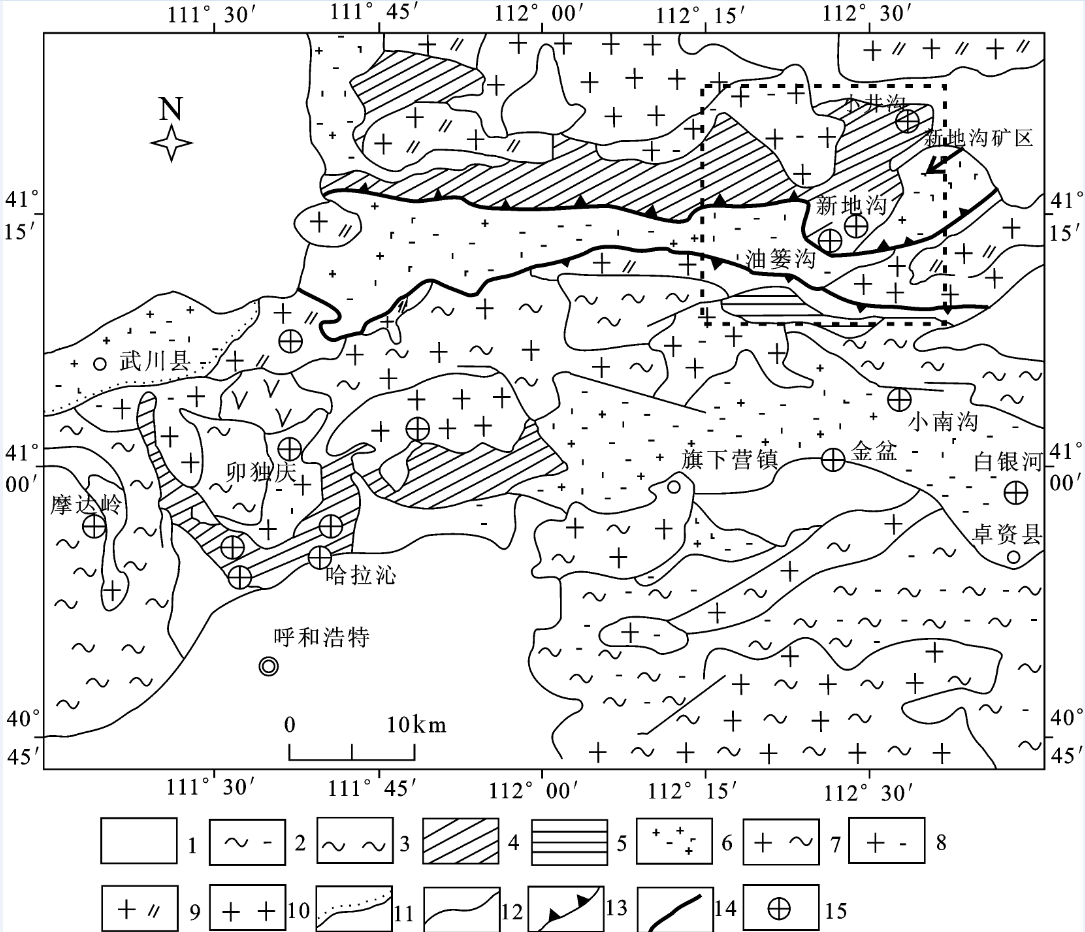
 下载:
下载:
